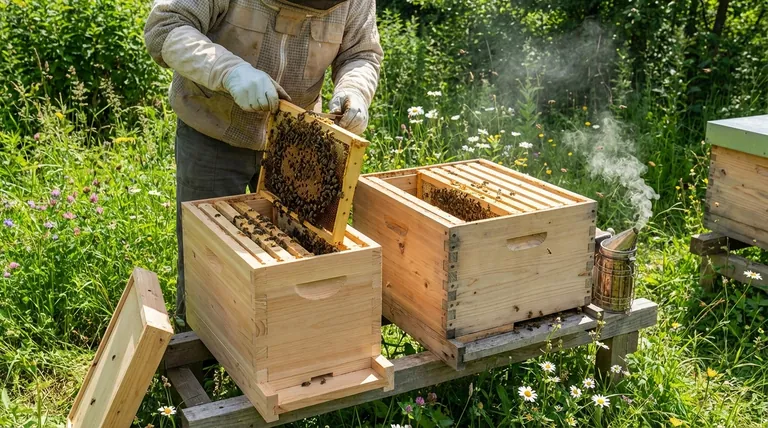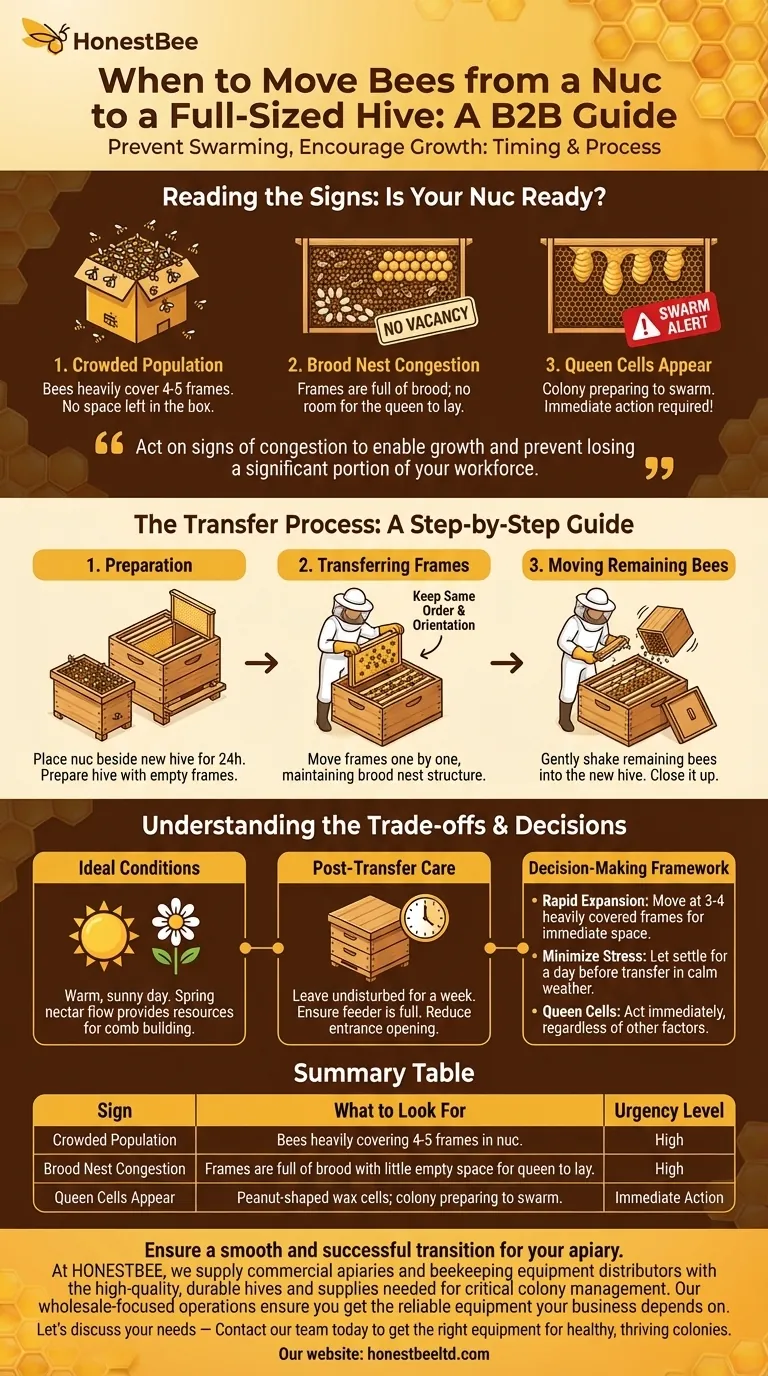Knowing when to move your bees from a nucleus box (nuc) to a full-sized hive is a critical step in colony management. The primary signs are a booming population that fills the box, brood nest congestion that leaves the queen no room to lay, and the appearance of queen cells, which signals the colony is preparing to swarm. Acting on these signs promptly prevents losing your bees and encourages healthy growth.
The decision to move bees from a nuc to a full hive is not just about giving them more space; it's about preempting the colony's natural impulse to swarm. By acting on signs of congestion, you enable their growth and prevent losing a significant portion of your workforce.

Reading the Signs: Is Your Nuc Ready?
A nucleus colony's primary goal is to expand. Your job is to recognize when their small starter home is becoming a limitation. Look for these three definitive signs during your inspections.
The Population is Crowded
The most obvious signal is the sheer number of bees. When you open the nuc, you should see bees covering most, if not all, of the frames.
If the bees have filled out at least four of the five frames in the nuc, it is a strong indicator that they are ready for a larger space.
The Brood Nest is Congested
A healthy queen is an egg-laying machine. Congestion occurs when she runs out of prepared cells to lay in.
Look at the frames in the center of the nuc. If they are nearly full of eggs, larvae, and capped brood, with little empty space, the queen is feeling cramped. This is a clear sign they need more room for expansion.
Queen Cells Appear
This is the most urgent signal. If you see peanut-shaped wax cells, known as queen cells (or swarm cells), the bees have already decided they are too crowded.
They are raising a new queen to leave with, and the old queen will soon depart with half the colony in a swarm. If you see these, it is time to act immediately to provide more space.
The Transfer Process: A Step-by-Step Guide
Once you've determined it's time to move, the process itself is straightforward. The goal is to minimize stress and disruption to the colony.
Step 1: Preparation
It's a common and beneficial practice to place the nuc box directly beside or on top of the new, permanent hive location for 24 hours before the transfer. This helps orient the bees to their new home's location.
Prepare your new hive body by placing empty frames on the outer sides, leaving a gap in the middle that is large enough to hold all the frames from the nuc.
Step 2: Transferring the Frames
On a calm, warm day, open the nuc and carefully lift out each frame. Transfer them one by one into the center of the new hive.
It is crucial to keep the frames in the same order and orientation they had in the nuc. This preserves the structure of the brood nest and causes the least amount of disruption for the queen and nurse bees.
Step 3: Moving the Remaining Bees
After all frames are moved, a significant number of bees will remain in the nuc box and on its lid.
Gently shake the remaining bees from the nuc box and lid directly into the new hive on top of the frames. Place your inner and outer covers on the new hive to close it up.
Understanding the Trade-offs
While the process is simple, a few decisions can impact the colony's stress levels and long-term success.
Ideal Conditions
The best time to transfer your colony is during a calm, warm, and sunny day. Performing the move in poor weather can chill the brood and cause unnecessary stress on the colony.
Seasonality
Timing the move with the season is also important. A transfer during a spring nectar flow provides the colony with ample resources to build out the new frames with fresh wax comb quickly.
Post-Transfer Care
After the move, leave the colony undisturbed for about a week. Your only task is to ensure their feeder is full. This "peace period" allows them to reorient and establish their new home.
It is also wise to reduce the hive entrance to a small opening (2-3 inches). The colony's population is still small for the new space, and a smaller entrance makes it easier for them to defend against robber bees from other hives.
Making the Right Choice for Your Colony
Your approach should be guided by the state of your colony and your primary goal as a beekeeper.
- If your primary focus is rapid expansion: Move the bees as soon as 3-4 frames are heavily covered with bees and brood to give the queen immediate laying space.
- If your primary focus is minimizing stress: Let the bees settle for a day after transport before transferring them into the new hive on a calm, warm afternoon.
- If you see queen cells: Act immediately, regardless of other factors. Providing more space is the only way to try and prevent the colony from swarming.
By responding to these clear signals, you transition from simply housing your bees to actively managing their health and success.
Summary Table:
| Sign | What to Look For | Urgency Level |
|---|---|---|
| Crowded Population | Bees heavily covering 4-5 frames in the nuc. | High |
| Brood Nest Congestion | Frames are full of brood with little empty space for the queen to lay. | High |
| Queen Cells Appear | Peanut-shaped wax cells; colony is preparing to swarm. | Immediate Action Required |
Ensure a smooth and successful transition for your apiary.
At HONESTBEE, we supply commercial apiaries and beekeeping equipment distributors with the high-quality, durable hives and supplies needed for critical colony management steps like moving from a nuc. Our wholesale-focused operations ensure you get the reliable equipment your business depends on.
Let's discuss your needs — Contact our team today to get the right equipment for healthy, thriving colonies.
Visual Guide

Related Products
- 5 Frame Wooden Nuc Box for Beekeeping
- Twin Queen Styrofoam Honey Bee Nucs Mating and Breeding Box
- Automatic Heat Preservation 6 Frame Pro Nuc Box for Honey Bee Queen Mating
- Styrofoam Mini Mating Nuc Box with Frames Feeder Styrofoam Bee Hives 3 Frame Nuc Box
- 5 Frame Langstroth Poly Nuc Corrugated Plastic Nuc Boxes
People Also Ask
- What is the advantage of overwintering a nucleus? A Strategic Asset for Beekeeping Success
- What frames should be moved into the queenless hive when requeening with a nuc? Ensure a Successful Queen Introduction
- How many frames does a typical wooden nuc box hold? A Guide to Choosing the Right Size
- What are the benefits of starting a new bee colony in a nuc box? Boost Colony Success with Efficient Beekeeping
- What is the most common type of standard nuc? The 5-Frame Nuc Explained



















